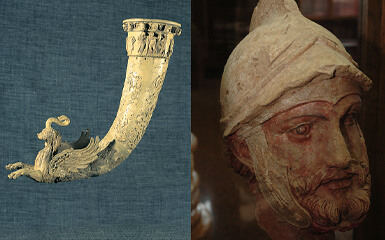Ashgabat
Alem Ferris wheel
State Museum
Fine Arts museum
Wedding Palace
Nisa fortress
Memorial Complex
Ertogrul Gazi Mosque
Neutrality monument
Independence Park
Turkmenbashi Ruhy Mosque
Olympic Village
Ylham Alley
Carpet Museum
Monument of Lenin
Ahal Region
Abivert
Altyn Depe
Annau
Darvaza
Geokdepe
Kowata
Mane baba
Zengi baba
Nedir Shah
Nokhur
Parzdepe
Sarahs baba
Seyit Jemaleddin mosque
Shahrislam
Ulug depe
Mary region
40 cupolas
Akcha Kala
Ancient Merv
Badkhyz
Chilburj
Gebeklytepe
Geok Gumbaz
Gurtly Depe
Kharoba Koshuk
Talkhatan Baba
Yekedeshik
Dashoguz region
Ashyk Aydyn Pir
Devkeshen
Ismamit ata
Kalaly-gyr
Kaplankyr Nature Reserve
Kunya-Urgench
Damla
Balkan region
Dehistan
Yangikala
Awaza
Gozli ata
Kemal ata
Mashat ata
Paraw bibi
Lunar Mountains
Shevlan Baba
Igdy kala
The State Museum of the State Cultural Centre of Turkmenistan

The State Museum of the State Cultural Centre of Turkmenistan is a treasury of the national heritage. It is located at the picturesque foothills of the Kopetdag Mountains in the south of Ashgabat. The museum building, constructed in oriental style, was opened on November 12, 1998. Later on, two museums, namely, the Museum of Ethnography and Local History of Turkmenistan and the Museum of the President of Turkmenistan, were opened at two buildings constructed on its territory in 2009.
The history of the State Museum dates back to the late 19th century. The first museum collections in Turkmenistan were created in 1894. They witnessed the centuries-old history of the Turkmen people and included archaeological and ethnographic artefacts, exhibits and works of fine art. Over the years, the name of the museum has been changed several times.
The ground floor of the central building of the State Museum hosts the halls of independence, carpet and temporary exhibitions. On the first floor, there are the halls of Ancient History and the ancient states of Margush and Parthia, and two halls of the Middle Ages.
People can discover the life of the primitive societies of the Paleolithic, Mesolithic, Neolithic and Eneolithic periods on the territory of Turkmenistan in the hall of Ancient History. Here, the Dam Dam Cheshme and Jebel caves, the cultures of Jeytun and Anau are presented in dioramas, photos and other information. The city of Altyn Depe and its archaeological findings are also displayed in the hall.
The findings displayed in the hall of Margush prove that the ancestors of the Turkmen people were the first to domesticate horses. The exhibits of the exposition demonstrate that the inhabitants of this ancient country skilfully made jewellery and products from stone, marble, bronze, silver, and ceramics.
A set of artefacts found in the fortresses of Old and New Nisa, which are considered the heart of the powerful state of Parthia, located on the territory of southern Turkmenistan, form the collection of the hall of Parthia. The rhyta, the figurines made of marble, silver, gold, bronze, and ivory discovered in Nisa, reflect the peculiarities of Hellenistic traditions, and represent magnificent examples of Parthian art.
Three periods, including in the Early Middle Ages (the 5th-9th centuries), the High Middle Ages (the 9th-12th centuries) and the Late Middle Ages (the 12th-16th centuries), are displayed through archaeological findings, reconstructions, dioramas, photos and official documents in the hall of the Middle Ages. Museum visitors are especially interested in the artefacts related to the period of the medieval states founded by the Turkmen people, in the models of historical and architectural monuments in Merv, Kunya-Urgench, Anau, and in the samples of ceramic, enamelled, and bronze ware.
The souvenirs presented to the head of the state are exhibited in the Museum of the President of Turkmenistan, which displays materials on the foreign and domestic policy of Turkmenistan, and on the work of the Turkmen leader.
A characteristic feature of the exposition of the Museum of Ethnography and Local History of Turkmenistan is demonstration of the original traditions and customs of the Turkmen people. Everyday life, national costumes, crafts, military weapons, musical instruments, and silver jewellery are displayed in the museum. A significant part of the collection is dedicated to the nature of Turkmenistan. It starts with scientific hypotheses about the origin of life on the Earth, and the fossil plants and animals found on the territory of Turkmenistan. The physical and geographical characteristics and the nature of Turkmenistan, as well as the unique Karakum Desert, are represented by the dioramas of the Koytendag, Gaplangyr, Badhyz, Kopetdag, Syunt Hasardag, Repetek, Amu Darya and Hazar State Nature Reserves. The petrified animals and plants are also included in the exposition. The museum staff managed to recreate moments from the life of the native land and give them a national colour.
The State Museum of the State Cultural Centre of Turkmenistan has three branches, including in the Museum of Independence, the Museum of Neutrality and the Museum of Constitution. Thus, the Museum of Independence, located in the building of Independence Monument, exhibits the paper bonds and coins, both old and issued in the years of independence of Turkmenistan, as well as the coins issued on the eve of significant dates, orders, medals, old and modern jewellery, golden and silver coins.
The exposition of the Museum of Neutrality contains information about the history of Turkmenistan, about the State regulatory documents of the President of Turkmenistan, and about the foreign and domestic policy of Turkmenistan. Due to the originality of the Monument of Neutrality, the floor, where the museum is located, hosts modern interactive computers with touch screens and the necessary information.
The Museum of Constitution is located on the first floor of the building of Constitution Monument. The museum exposition contains the exhibits dedicated to the Constitution, the history of independent neutral Turkmenistan, and the important sectors of the national economy. The museum collection includes old handwritten books, national costumes and jewellery, as well as a special exposition about the stages of development and history of the country.

